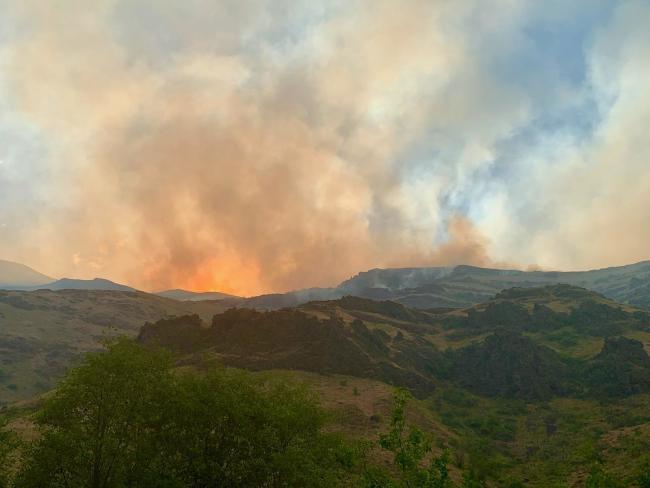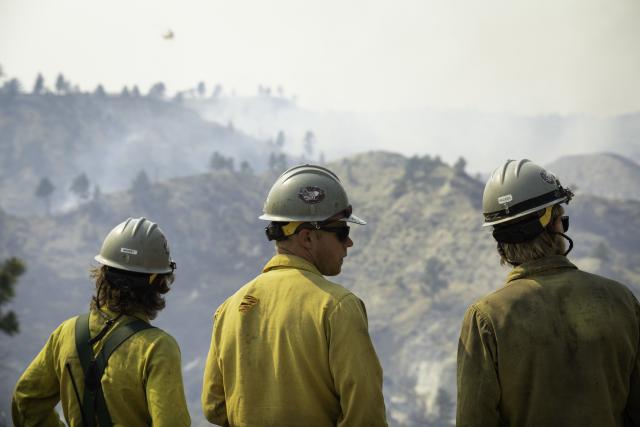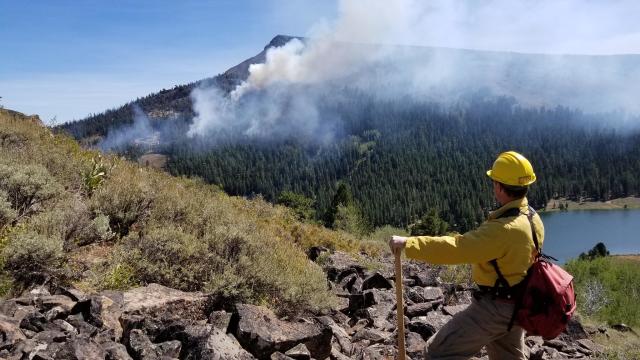BLM recognizes National Wildfire Awareness Month (Part 2 of 3)
Listen
Subscribe
Related Content
To continue our three-episode podcast series on wildfire awareness, this week’s episode delves into the importance of effective communication pertaining to fire prevention, examining best practices and strategic approaches employed by fire crews, as well as the major challenges and widespread public misconceptions surrounding wildfires.
Transcript
NARRATOR [Mitchell C. Leverette, Public Affairs Specialist]: Welcome back to on the ground a Bureau of Land Management podcast. I'm Mitchell Leverette and this week we're continuing our conversation with Nick Howell, Eric Solomon and Piper Brandt, some BLM employees who work to prevent and fight wildfires. Nick works in investigations, fire prevention, and education in Utah, while Eric is a fire prevention and mitigation specialist in California. Piper is a public affairs specialist at the National Interagency Fire Center, or NIFC, in Boise Idaho. Last week we talked about the different ways the BLM fire program prepares for fire season, and this week 's conversation focuses more on the importance of good communication. Be sure to check back next week for part three when we'll delve into efforts to educate the public about fire prevention.
LEVERETTE: So, moving on to the next part of the episode, I really wanted to touch on the communications side of fire season. I work in public affairs in downtown Washington DC, at HQ, so communications, both internal and external, is a major part of my day-to-day routine. So, I can imagine that communications in fire season is just as crazy, if not even crazier, considering all the variables that come into play during fire season. So, I wanted to just kind of branch out and ask you guys what are some of the biggest communications challenges you guys experienced in your areas?
NICK HOWELL: Yeah, I feel like we communicate really well in the field especially on wildfire incidents. I guess you know some of the biggest communication challenges that we might face in the field, because we have a huge cooperator interagency relationships to make all of these programs mesh well and make sure that we are communicating effectively, if there was a challenge it's probably the electronic side of communicating with our cooperators. You know we're always trying to find new ways new platforms to share information with them and, you know, make sure that we can, you know, share pertinent reports and data with our interagency partners and that's really critical to being successful.
ERIC SOLOMON: I would definitely agree with that. I know that when we have interagency and unified command type fires where there may be several agencies that have lands that are affective that are affected or intertwined where there's a fire burning, we all want to make sure that the information that we're putting out is approved by all agencies and then we want to make sure that the information is also approved by our state office as well and our communications folks. So, when we're doing an initial attack fire and we're suppressing fire and we're trying to limit the damage of those fires, the communication part of that, we need standalone folks that can get that information out and who can kind of focus on gathering that information and getting it out to agencies and then, communication requires its own incident command as well, so, to find that flow and to work well with those agencies, I think is something that we strive for early on in fire season so that we can get all of that worked out so that when we do have fires everything is kind of in place and everybody knows what their role is.
PIPER BRANDT: Yeah, and I can speak about the high level of things. So, here at NIFC, we have an information line and during the summer it gets really busy. With reporters and media calling in, I mean it can be anybody from a member of the public wanting certain fire information on something burning really close to their house, or reported from the New York Times, and so we have to constantly field those calls all day, especially in the summer when it's really busy. Which that can be challenging because information is changing so quickly in the field and we have to be knowledgeable about so many different aspects of fires across the country and then getting that information to the public as quickly as we can. It gets a little challenging, particularly when there's a lot of fires and there's a lot of things happening, but it's really important to us to get that information as accurate as possible and out as quickly as we can.
LEVERETTE: Awesome, yeah, for sure. I'm going to stick with you Piper: What are some common misconceptions that the public has about wildfires or even land or personnel management.
BRANDT: Yeah, I think the public…they seem to be surprised about all the things that can start wildfires. I mean it can be something as small as like flicking a cigarette butt out of your window into a patch of dry grass and that can start a huge wildfire, and, again I'll say it, it's really important to make sure that your campfires are completely dead out before you leave them. Like, even if you think it's completely out. It’s down to coals and a wind gust can come through and then make it blow up again. So, things like that making sure that people understand all the different causes of fires that they may not think like oh I'm not capable of that it won't be me will be somebody else, but like just being conscious of little things like that and another challenge we face is kind of communicating the, like how we dispatched resources and how we manage resources particularly in the summer when we're up to preparedness level 5 which is the highest it goes when we have a lot of places with fires to and only so many resources to be available to send, and kind of explaining that piece like we prioritize which areas need more resources than others that's that gets challenging.
LEVERETTE: Yeah, for sure, and what you're saying kind of lines up with what Eric mentioned before. He said that a lot of the public don't realize how much stuff can actually start a wildfire is that right, Eric?
SOLOMON: Absolutely, you know everything from barbecues to target shooting to where people park. If they're parking on dry vegetation there's just so many things and I make a lot of public contacts and I do a lot of patrolling out in my area. I work in a pretty desert like area where there's a lot of primitive and rural camping, and folks don't always understand that a generator can get extremely hot, and if you place it next to some dry grass and that's a continuous area of vegetation that a small fire can quickly grow especially with winds out in the desert and I think most of the time it's received really well and folks just they don't understand, so when you have a friendly fire prevention person coming up just to have a conversation and to give you some pointers and some ideas and some things that you could do to help mitigate fires something as simple as having shovels and water and fire extinguishers with you whenever you're out, really goes a long way and I think that for all of the prevention folks across the United states that all the work that we've done educating folks have probably resulted in the reduction of a lot of fires that could be extremely damaging.
LEVERETTE: Right of course, of course. Now are there any communication styles or methods that are used across fire crews. Does each sort of fire unit have their own sort of preferred method of how they get information back and forth?
SOLOMON: So, for me, I think these days social media plays a huge role in in fire education, fire information, but we also can't forget that there are areas, especially in my area, where technology is not as prevalent in some of those communities and folks are not as connected to the Internet as a lot of other places. So, that face-to-face communication, town halls, education, events going to community events, to fairs to offering community wildfire mitigation education training to those communities is really important, and it reaches a much larger audience than if we just depended on electronic social media.
LEVERETTE: Yeah, sure. I’d imagine that interpersonal communication adds an extra level that you might not see when you try to get information through social media or blast e-mail or just even posting up a blog. That face-to-face conversation is definitely something that can have an impact for sure.
SOLOMON: I think that's a great way to do that, that's one of my most preferred methods when I'm out doing public information work or talking about fire information is actually being out in those communities and being face-to-face with those community members and those residents, and it shows that the agency is doing everything that they can to provide them the information and education that they need.
BRANDT: Yeah, Eric is totally right. I mean, we post on social media regularly, every day, about wildfire information, but at the end of the day, I mean, you have folks that are out camping or hiking out of service, and they may not be up to date on wildfire restrictions. So, you know the Internet access isn't a factory out there, and it really does help to have people on the ground talking to people face-to-face, and, you know, not everybody even has access to the Internet or social media, so, you just can't replace that face-to-face interaction.
LEVERETTE: Thanks for listening to part two of this On the Ground podcast about the BLM fire program. Please come back next week when Nick, Eric and Piper will talk about how they try to help people understand how they can prevent wildfires when they're out enjoying BLM lands. I'm Mitchell Leverette, and I hope to see you next week for On the Ground.




